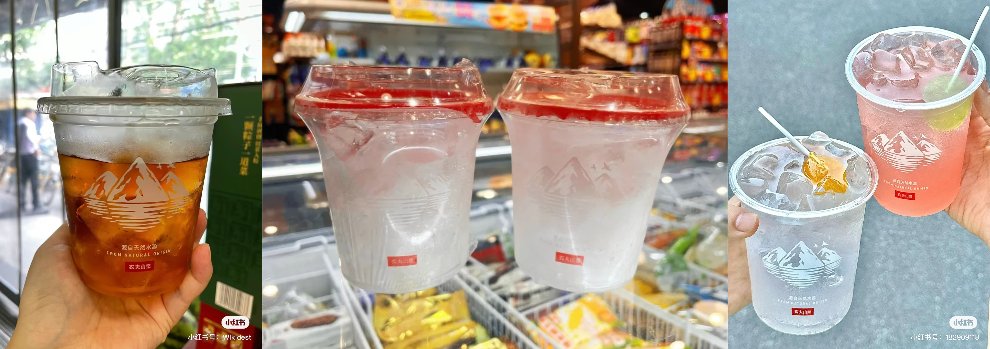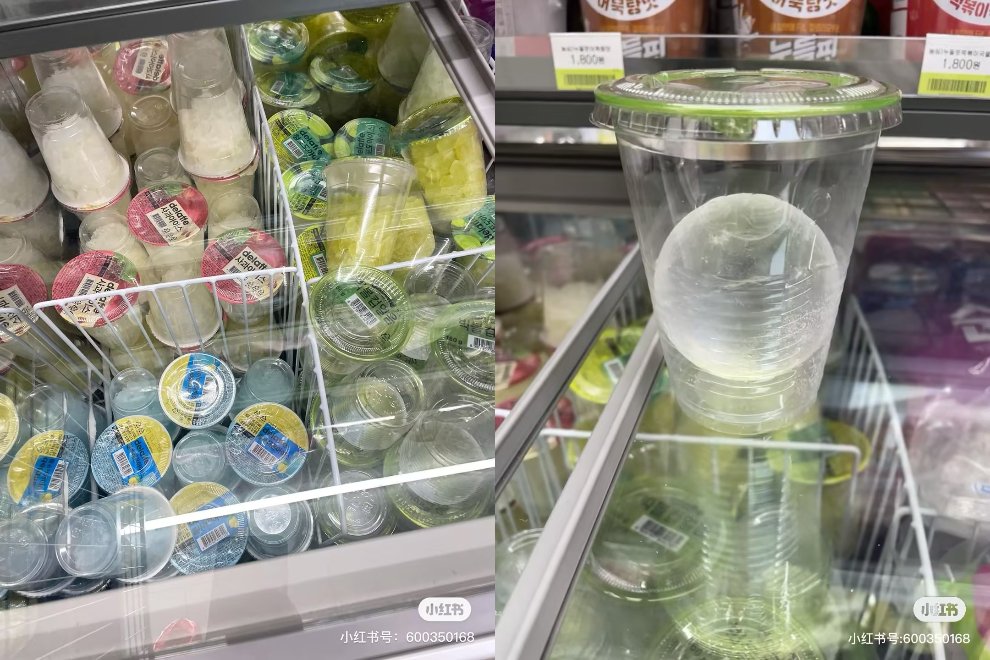From social media to retail shelves: The ice cup craze
In recent years, almost every summer has set new records for high temperatures. Heatwaves surpassing 35 degrees Celsius have prompted many working individuals to seek clever ways to escape the heat. For brands, creating simple yet practical seasonal products has become an annual challenge. This year, the answer might just be ice cups.

Examples of homemade ice cups. Images are from RED.
Ice cups first appeared on social platforms like RED and Douyin. They involve DIY combinations of ice cubes with various beverages, alcoholic drinks, or coffee to create a refreshing and delicious drink. Over the past two years, many bars have started offering packages that include ice cups paired with different styles of cocktails. Retailers like Hema Fresh, Lawson, and ALDI have also introduced innovative fruit-flavored ice sphere products. Due to their simple production process and wide application, nearly 500 newly registered businesses have entered the ice-making industry in the past three years.

Ice cups sold in Seven-eleven, Hema fresh and ALDI, average price is around 2-4 RMB. Images are from RED.
With Nongfu Spring entering the scene, the ice cup market is now witnessing a trend towards higher standards. As a renowned player in the soft drinks industry, Nongfu Spring opts to use edible ice to produce ice cups, a process that involves more complexity such as sterilization, injection moulding, and freezing. Even the ice cubes undergo sampling inspections before they can be brought to market. Currently, Nongfu Spring's ice cups are being sold in select Lawson convenience stores in Beijing, priced around ¥3-5 (41-69c) each.

Nongfu Spring's ice cups are priced on average ¥0.5-1 (7-14c) higher compared to other brands, crafted from a higher standard water source. Images are from RED.
In coffee-demanding countries like Japan and South Korea, annual consumption of disposable ice cups has reached 2.5 billion cups. In comparison, China's ice cup market is just beginning to take off. Whether it's cocktails, fruit juices, sparkling water, or coffee, all can interact effectively with ice cups, presenting significant potential in this field. However, for the ice cup market to sustain growth, strict control over product quality is essential to ensure product safety.

Ice cups sold in convenience stores in Japan and South Korea boast a wide variety in colors, flavors and designs. Images are from RED.
Despite foreign brands generally being perceived as safer in China, they often squander this advantage by failing to localise and understand the ecosystem and cultural nuances
Instead of chasing scale through aggressive franchising or racing to the bottom with price wars, Honeymoon and Ah-Ma Handmade are playing the long game: building brands rooted in culture, craftsmanship, and emotional connection
Luxury brands such as Burberry, Gucci, and Armani are selling heavily-reduced products at bulk warehouse Sam's Club - what does it mean for the brands?
China's Special Action Plan for Boosting Consumption is a positive for foreign brands in China, but there remain some challenges
With local competitors mastering manufacturing efficiency and aggressive pricing, foreign brands have wrestled with the challenge to remain relevant without succumbing to the price war. Heytea provides some valuable lessons for maintaining premium positioning
Mixue is now the largest fast food chain in the world by stores. It hasn’t got there by following the Western outsourcing model, rather building on a structure that takes advantage of China’s unique infrastructure
Mixue has surpassed Starbucks and McDonald's to become the world's largest fast food chain. As the details illustrate, it wasn't by accident. The company's record-breaking IPO looks set to fund its next round of expansion
Blind boxes are redefining value, experience, and ethics in consumption. The intersection of affordability, gamification, and sustainability is a powerful formula that brands can learn from and adapt.
Jack Ma launched New Retail with a roar in 2016 starting a scramble for the New Retail crown on both sides of the Pacific. The buzzword has since fizzled out and Alibaba has divested in much of its bricks & mortar retail properties, but the need to rethink retail is more important than ever. Here's why...
Despite being winter, Naimi's novel fried chicken-looking ice creams are flying out of the chiller. Their success provides many valuable lessons for brands selling in China
Xianyu's foray into physical retail illustrates five key lessons for retailers - both online and office - in how to differentiate and engage your target audience
Photos of supermarkets like Sam’s Club being squeezed with throngs of shoppers in the CNY period
Hyper-local regional specialities are becoming increasingly popular in China based on their grassroots authenticity and uniqueness, presenting valuable lessons for foreign brands
A concise summary of last month's key marketing developments in China, highlighting valuable insights and their implications for brands.
China's coffee revolution is brewing. From Cotti Coffee's rapid rise to shifting cultural trends, discover why coffee could become China's next daily staple.
We’ve seen a number of companies in China back away from selling branded products to focus on selling commodities, parts or white labels. Based on the nature of the Chinese market, what is the best approach?
From adapting flavours to creating viral moments, Oreo has continually evolved to meet the changing tastes and lifestyles of Chinese consumers, transforming the foreign brand into a household favourite.
Blind boxes are trending in China. Supermarket blind boxes were one of the big sellers at this month's 11-11 shopping festival, with everything from beer to baby diapers mystery boxes popular. Here’s why it makes so much sense.
After spreading over social media, China’s youth have demonstrated their need for community and adventure en masse causing a stir on their 50km group ride
MINISO has launched MINISO LAND, attracting massive crowds. Its first global “IP theme park-style” flagship blends globally- known IPs into an immersive shopping experience.
Social media feeds increasing filled with “rough life” posts, alongside the popularity of more authentic retail spaces are just two examples of how Chinese consumers are seeking more real, less polished marketing
China is experiencing a shift—or even a dilemma—in its bricks-and-mortar retail landscape. While high-end malls are seeing declines, non-standard commercial spaces are on the rise. Among these, Beijing’s THE BOX Youth Energy Center is redefining the offline retail experience by tapping into the spending power of the younger generation.
Chinese youth embody a rich tapestry of lifestyles and values that defy easy categorization. In a social media world saturated with flashy façades and overly curated personas, many still celebrate authenticity and self-discovery. This creates opportunities for brands to craft fresh, compelling stories that resonate with their desire for genuine connection.
As Chinese consumers increasingly prioritize health and wellness, fresh milk and fruit tea brands are stepping up, with HEYTEA standing out prominently. This article explores HEYTEA's health-focused marketing strategies and provides insights for brands looking to cultivate health-oriented perceptions.
Although summer has come to an end in China, the enthusiasm for ice cups remains strong. Coffee ice cubes and fruit-flavoured ice ball cups have further encouraged people to explore DIY mixers and enhance their beverage experiences.
As new generations redefine what weddings look like, brands are seizing the moment to connect with young couples seeking authenticity and personalization.
China's consumer landscape is increasingly divergent. Lower-tier cities are rebounding faster and showing greater resilience than first- and second-tier cities. While large catering businesses struggle, smaller restaurants thrive. How can brands understand these diverging trends and their implications? Read on to find out more.
Corn-based coffee and drinks are trending in China, attracting wellness-focused consumers with their creative versatility, health appeal, and nostalgic flavours. Stable supply chains and regional pride further enhance their popularity, turning traditional corn into a modern beverage hit.
Beijing's total package for stimulus this year may be its largest yet in nominal terms, but how will it impact the all-important consumption segment?
A number of high-end restaurants in China have closed or cut prices to stay afloat in the fierce dining market. However, we're seeing restaurants that blend dining with immersive experiences dining popular among young consumers, without lowering prices. Even without supply chain or scale advantages, these places are gaining a distinct competitive edge.






























